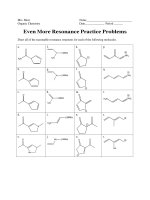Even more sedimentary rocks
Bạn đang xem bản rút gọn của tài liệu. Xem và tải ngay bản đầy đủ của tài liệu tại đây (3.95 MB, 43 trang )
Today’s Lecture:
Chapter 7: Sedimentary Rocks
Sedimentary structures:
• Inferring depositional
processes from
sedimentary rocks
•Sea-level changes
& the facies concept
Sedimentary structures:
Features observed within a single bed.
Within sedimentary
beds, distinctive
structures can
usually be seen.
These include
systematic
variations in grain
size and sorting,
internal bedding
features, etc. that
are diagnostic of
particular
depositional
processes.
Sedimentary Structures
Graded beds:
Show a gradual
change in
particle size as
you move from
the bottom of a
bed to the top.
Bed 2
Bed 1
Fig. 7.26a
Stephen Marshak
Sedimentary Structures
Graded beds:
Show a gradual
change in
particle size as
you move from
the bottom of a
bed to the top.
Bed 2
Bed 1
Bottoms of beds: Coarser
Sedimentary Structures
Tops of beds: Finer
Graded beds:
Show a gradual
change in
particle size as
you move from
the bottom of a
bed to the top.
Bed 2
Bed 1
Graded Bedding
Finer
The bed to the
right shows a
change from
large grains at
the bottom, to
small at the
top. This is
called “normal”
grading.
Coarser
Graded Bedding
Lower Velocity
As transport
velocity declines,
coarser particles
settle out first
(see video
on turbidity
currents).
Higher Velocity
Graded Bedding
Lower Velocity
Thus, graded
beds tell us
how flow
velocity
changed
during
deposition!
Higher Velocity
Sedimentary structures: Cross-Bedding
Cross-bedding is
internal bedding
that is tilted at an
angle to the
primary bedding.
Cross beds are
formed by a scour
and fill transport
process involving
either wind or
water (see
ripple movie).
First we need to
distinguish between
primary bedding vs.
internal layering.
Primary bedding
vs. internal layering
Contacts between
sedimentary beds
Primary
Bed
Primary bedding
vs. internal layering
Internal,
inclined layers
Contacts between
sedimentary beds
Primary bedding
vs. internal layering
Internal
inclined layers
Contacts between
sedimentary beds
More cross-bedding
Bed contacts”
Fig. 7.25abc
W. W. Norton
More cross-bedding
Cross beds
Bed contacts”
Cross-bedding
Transport direction
Tilt-direction of cross beds indicates the
direction of transport (e.g., wind direction or
direction of water flow).
Large-scale cross-beds like these
What a geologist sees.
Which way did the wind blow?
What a geologist sees.
Paleowinds
Sedimentary Structures: Ripple Marks
Ripple marks form when moving wind or water
causes sedimentary grains to “hop” along the bottom.
Fig. 7.27a
Stephen Marshak
Ripple marks can be either symmetrical (formed by waves
sloshing back and forth), or symmetrical (formed by water
or wind flowing in one direction).









